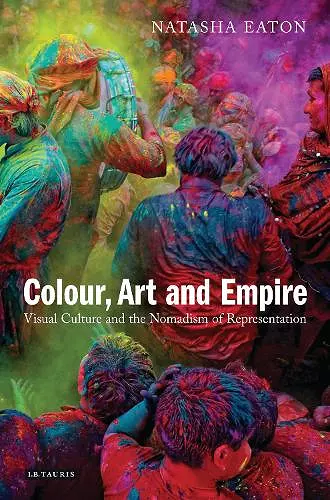Colour, Art and Empire
Visual Culture and the Nomadism of Representation
Format:Hardback
Publisher:Bloomsbury Publishing PLC
Published:28th Oct '13
Currently unavailable, our supplier has not provided us a restock date

Colour wreaks havoc with western expectations of biological determinism, objectivity and eugenics. Beyond the cracks of such discursive practice, colour becomes a sentient and nomadic retort to be pitted against a perceived colonial hegemony.
Colour, Art and Empire explores the entanglements of visual culture, enchanted technologies, waste, revolution, resistance and otherness. The materiality of colour offers a critical and timely force-field for approaching afresh debates on colonialism. This book analyses the formation of colour and politics as qualitative overspill. Colour can be viewed both as central and supplemental to early photography, the totem, alchemy, tantra and mysticism. From the eighteenth-century Austrian Empress Maria Theresa to Rabindranath Tagore and Gandhi, to 1970s Bollywood, colour makes us adjust our take on the politics of the human sensorium as defamiliarising and disorienting. The four chapters conjecture how European, Indian and Papua New Guinean artists, writers, scientists, activists, anthropologists or their subjects sought to negotiate the highly problematic stasis of colour in the repainting of modernity. Specifically, the thesis of this book traces Europeans' admiration and emulation of what they termed 'Indian colour' to its gradual denigration and the emergence of a 'space of exception'.
This space of exception pitted industrial colours against the colonial desire for a massive workforce whose slave-like exploitation ignited riots against the production of pigments - most notably indigo. Feared or derided, the figure of the vernacular dyer constituted a force capable of dismantling the imperial machinations of colour. Colour thus wreaks havoc with Western expectations of biological determinism, objectivity and eugenics. Beyond the cracks of such discursive practice, colour becomes a sentient and nomadic retort to be pitted against a perceived colonial hegemony. The ideological reinvention of colour as a resource for independence struggles make it fundamental to multivalent genealogies of artistic and political action and their relevance to the present.
'Eaton uses the topic of colour to create daring, provocative and dazzling new encounters with colonial and postcolonial cultural and material worlds. With a particular focus on South Asia, this book asks us to think about the interrelation of colour, art and empire in ways which explode any easy exoticisation of the imperial palette. The spectrum of ideas which Eaton uses to guide us through the labyrinthine entanglement of colour and colonialism is simply breathtaking.' Sarah Victoria Turner, Lecturer in History of Art, University of York, UK 'In this fascinating and highly readable book, Natasha Eaton gives us a brilliant analysis of colour as an aesthetic tool with which colonial spaces and bodies were negotiated, organised, displayed and resisted in India, by both Indian and European artists. Eaton unpacks the complexities of colour as a material substance, an intuitive expression, a sign of alterity and, as importantly, a paradigm of nationalist sensibility.' Romita Ray, Associate Professor of Art History, Syracuse University, USA 'These are richly hued and dazzling essays, simmering with insightful provocations. Eaton's antiquarian fascination and exceptional conceptual agility generate fabulous alignments and juxtapositions. The prism used here makes a world we had almost forgotten vital and compelling, drawing blurred margins through the "mind's indigo" and rendering them with acuity.' Christopher Pinney, Professor of Anthropology and Visual Culture, University College London, UK
ISBN: 9781780765198
Dimensions: unknown
Weight: 849g
416 pages